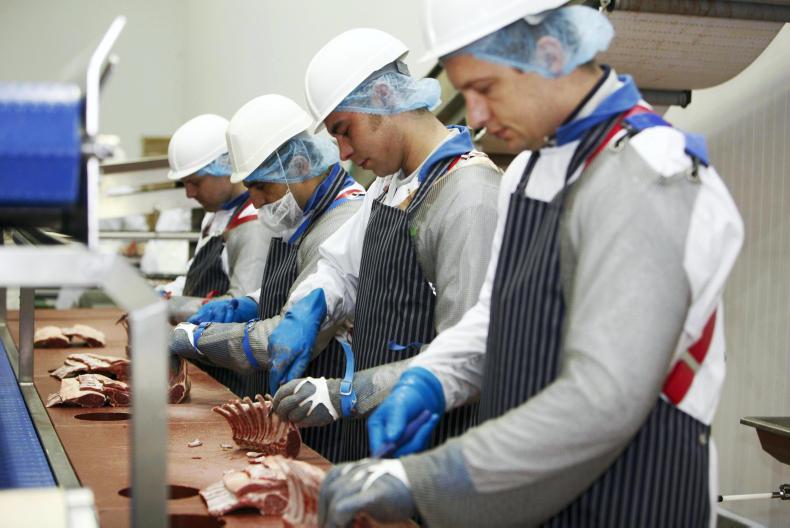Prices paid in the factories remain steady, but hogget finishers are far from happy with the status quo. In the main, farmers are securing €4.75/kg including bonuses for hoggets and producer groups are securing €4.80/kg.
However, some factories in the east have attempted to pull back prices by 5c/kg, with a maximum price of €4.70/kg for quality assured (QA) hoggets available to farmers and €4.60/kg for non-QA hoggets.
Factory base quotes remain steady on last week, with the exception of Ballon Meats, which pulled back its all-in quote by 10c/kg to €4.60/kg.
It has not been a good week in terms of factory-farmer relations. The news that Kepak Athleague is following Irish Country Meats’ lead and introducing clipping charges does not bode well for farmers – see page three for more details.
In addition, speculation is rising that Irish Country Meats is combating overweight hoggets, with Kildare Chilling to follow suit.
Farmers claim that, today, any hogget with a carcase weight of 25kg or more will not receive any bonuses in the ICM plants. For example, at today’s ICM quote, overweight hoggets will be paid an end price of €4.50/kg to a maximum weight of 22.5kg.
An Irish Country Meats spokesperson did not confirm the changes, but did say they are looking at ways to reduce the percentage of overweight hoggets being presented for slaughter.
Kill-out
Lambs that have received heavy meal feeding for a long period of time are reported as killing very well and delivering heavier carcase weights that farmers envisaged. In cases, these lambs are killing out at 46% to 47%, which should be taken into account in drafting decisions.
Difficult trade
According to market specialist with Bord Bia Declan Fennell there is a combination of three main factors holding back Irish sheep prices.
He said in January there is usually a seasonal lull and retailers focus their attention on cheaper protein sources such as pork at this time of year. Fennell said the weakness of sterling is not helping the trade and makes UK lamb more competitive relative to Irish lamb.
The third reason for lower prices this year is the higher kill. He said last week saw the kill rise 7% compared with the corresponding week last year, which is not helping matters.
However, on a positive note Fennell said we should turn the corner soon and retailers will start to focus their promotions on lamb again. He said a later Easter this year will be beneficial. New Zealand exports may also be limited this year with the currency situation.
Read more
Northern view: 370p/kg at best for hoggets
Groundhog Day in the marts
In-lamb ewes sell to €215 at Ballymena
Prices paid in the factories remain steady, but hogget finishers are far from happy with the status quo. In the main, farmers are securing €4.75/kg including bonuses for hoggets and producer groups are securing €4.80/kg.
However, some factories in the east have attempted to pull back prices by 5c/kg, with a maximum price of €4.70/kg for quality assured (QA) hoggets available to farmers and €4.60/kg for non-QA hoggets.
Factory base quotes remain steady on last week, with the exception of Ballon Meats, which pulled back its all-in quote by 10c/kg to €4.60/kg.
It has not been a good week in terms of factory-farmer relations. The news that Kepak Athleague is following Irish Country Meats’ lead and introducing clipping charges does not bode well for farmers – see page three for more details.
In addition, speculation is rising that Irish Country Meats is combating overweight hoggets, with Kildare Chilling to follow suit.
Farmers claim that, today, any hogget with a carcase weight of 25kg or more will not receive any bonuses in the ICM plants. For example, at today’s ICM quote, overweight hoggets will be paid an end price of €4.50/kg to a maximum weight of 22.5kg.
An Irish Country Meats spokesperson did not confirm the changes, but did say they are looking at ways to reduce the percentage of overweight hoggets being presented for slaughter.
Kill-out
Lambs that have received heavy meal feeding for a long period of time are reported as killing very well and delivering heavier carcase weights that farmers envisaged. In cases, these lambs are killing out at 46% to 47%, which should be taken into account in drafting decisions.
Difficult trade
According to market specialist with Bord Bia Declan Fennell there is a combination of three main factors holding back Irish sheep prices.
He said in January there is usually a seasonal lull and retailers focus their attention on cheaper protein sources such as pork at this time of year. Fennell said the weakness of sterling is not helping the trade and makes UK lamb more competitive relative to Irish lamb.
The third reason for lower prices this year is the higher kill. He said last week saw the kill rise 7% compared with the corresponding week last year, which is not helping matters.
However, on a positive note Fennell said we should turn the corner soon and retailers will start to focus their promotions on lamb again. He said a later Easter this year will be beneficial. New Zealand exports may also be limited this year with the currency situation.
Read more
Northern view: 370p/kg at best for hoggets
Groundhog Day in the marts
In-lamb ewes sell to €215 at Ballymena






 This is a subscriber-only article
This is a subscriber-only article










SHARING OPTIONS: